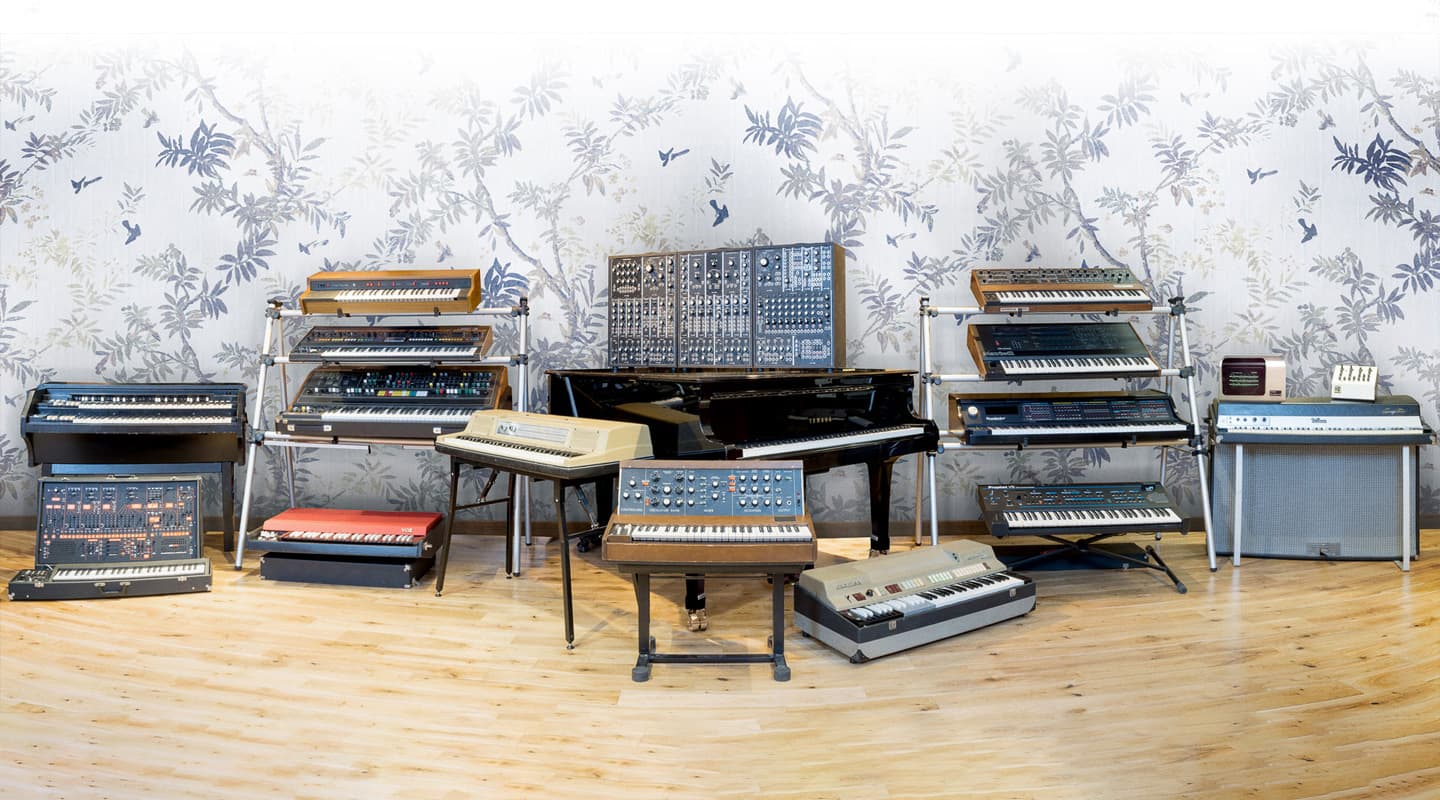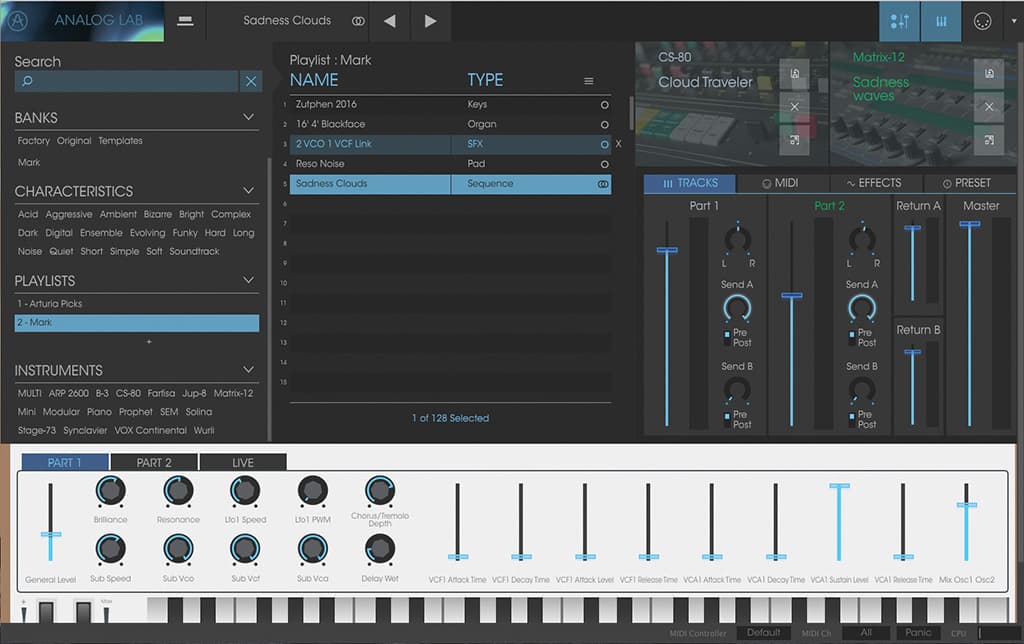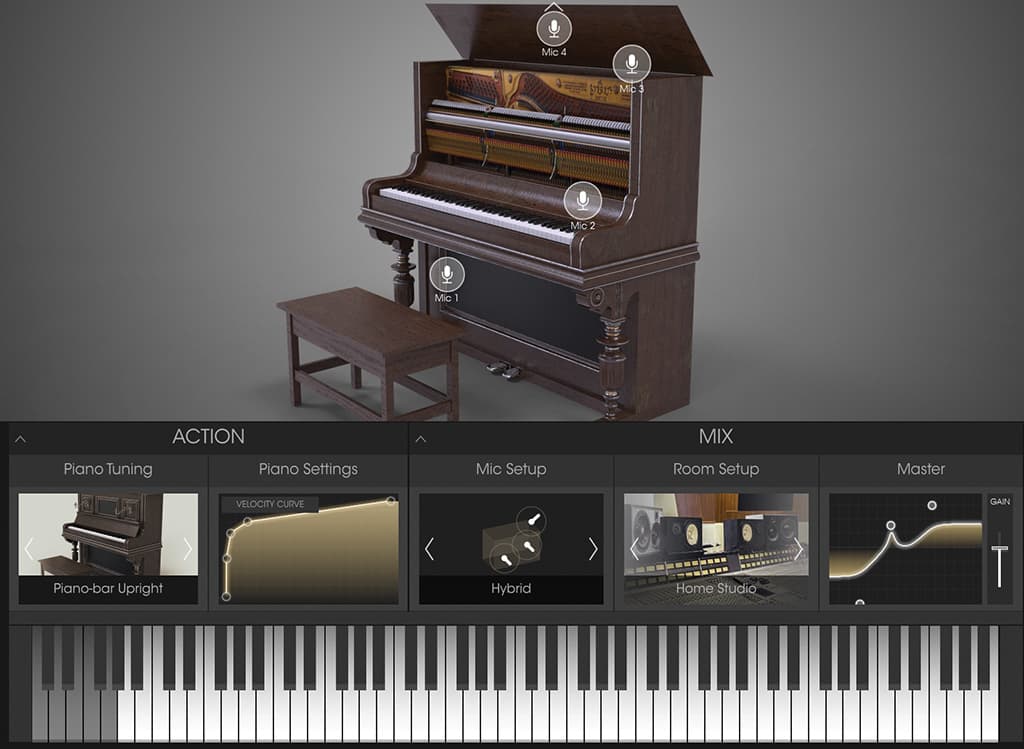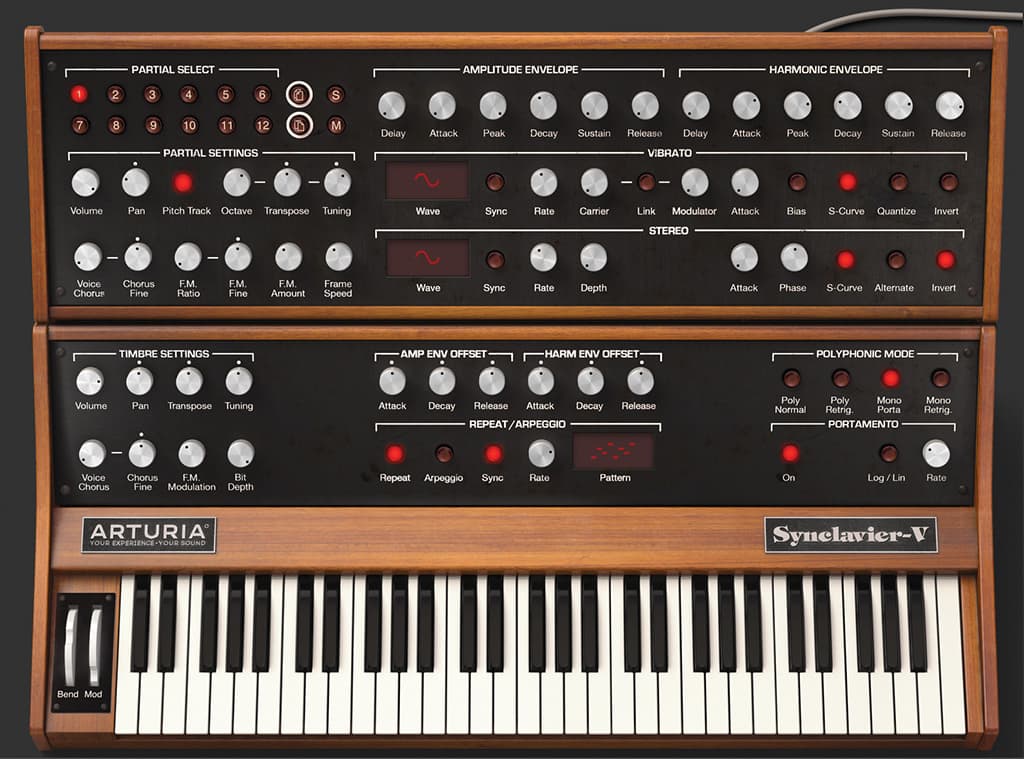
Review: Arturia V Collection 5
All the numbers add up as Arturia’s fifth V Collection grows with five new instruments.
Arturia’s V Collection is a virtual candy store for vintage synth enthusiasts. They’ve been used on countless records as stand-ins for the often unattainable ‘real deal’, and the collection keeps growing. The fifth instalment has five new keyboards added to the mix, had its main menu system overhauled, and, would you believe it, now features resizable windows from 60-200% — no need to squint any longer!
Before we get into the new bits of gear, let’s recap and see what else Arturia has been fiddling with. Three of the newer additions — Matrix 12V, Solina V and Vox Continental V — remain unchanged other than the zoom factor. Others have had cosmetic changes, like the ARP 2600V, which has shed its Blue Marvin skin for the 2601 orange and black colour scheme. Oddly, the Jupiter 8V has moved away from the original hardware colour scheme for a completely new look.
Others have been rearranged. The Modular V’s floppy patch cable physics have been tightened up and the modules restacked with filters at the top and sequencer closer to the other controllers. Both the CS-80V and Oberheim SEM V have gone a little off script. Arturia pulled out the CS-80V’s secret door modulation assignment panel and put it ‘under the bonnet’, leaving more room on the surface to spread out those faders. There’s also no more annoying rotating fans behind the grille. The Oberheim SEM V’s arpeggiator, tune and portamento functions have been moved up into the top panel, adding pitch and mod wheels next to the wider keyboard. Arturia is obviously shooting for better usability rather than true-to-life panel layouts, which is a welcome change.
The previous version looked like you were squinting at a Wurlitzer through a letterbox slot, while the new one lets you see its legs. Underneath it also adds a five-slot pedal board with 11 effects to choose from, and an external LARC-looking reverb control.
The Prophet V is much snappier when flipping between the 5, VS and hybrid engines — they slide across rather than unfold excruciatingly slowly. The VS engine is much clearer now, with the modulation, wavetables, envelopes, etc, now all selectable via tabs, while the straight-up Prophet V has additional chorus and analogue delay pedals. Likewise, as well as getting nicer-looking wooden end cheeks, the Mini V’s additional modulation/arp/motion flip-out screen looks much more modern.

Analog Lab has undergone the biggest makeover. The emphasis is on search, with a new search input field and keyword browsing. It’s also de-emphasised the distinction between Single and Multi-engine sounds. Your choices feed into a new mixer, which is tabbed rather than scrolled, though it still provides the same functions — level control, MIDI assign, effects and preset management. Now, when you edit the preset, the instrument appears in the top panel rather than in a separate window. One great update is the ability to have separate lots of mapped controls for each of the two multi-patch parts, previously you had one global set of controls for a Multi-patch. Also gone are the Chords and Snapshots related to Arturia’s Keylab hardware. You can always assign chords to buttons via Arturia’s MIDI control centre, and the new Playlist feature is a much easier way of building sets without the limitation of only having 10 available spots.
That’s enough about the old synths, here’s a deeper look into the new babies of the bunch.
NEED TO KNOW
Arturia V Collection 5
Virtual Keyboard Compilation

PIANO V: HAMMERED HOME
The piano is my first love, so I immediatey gravitated to Piano V. Delightfully rich piano sounds pour out of this collection: the Concert Grand and Classical Upright no-frills emulations are bang on the money and addictively satisfying to play, as are the more specialised Intimate Grand, Jazz Upright, and Piano-bar Upright models.
Among the controls, which include String Tension, Stretch Tuning and Unison Detune, I found the hammers’ Hardness setting to be particularly useful. It does exactly what it implies, altering the firmness of the attack, giving you an organic and natural way to balance the tone and feel of each note. In addition to the well executed standard piano tones are the more left-of-centre emulations like Glass Grand (which sound like: honky-tonk piano meets DX7) and Metal Grand (dry and attack-y).
In the Mix section of the GUI, you can play around with the mic setup, room setup, and a three-band master EQ. Upright piano models offer a choice of AB, Decca and Hybrid mic positions and a mixer lets you balance the mic levels. It would’ve been nice to see M/S as an option for the Grands, but the four choices of different AB and XY configs provide good variation in the piano’s spatial presentation. Room Setup places the piano anywhere from an Abandoned Warehouse to a Home Studio to a Wooden Room. Most are very usable and pleasing.
There are truer options if you’re searching for the ultimate virtual acoustic piano sound but, for what you’re getting in V Collection, Piano V is an outstanding newcomer to the pack that won’t disappoint.

SYNCLAVIER V: RETURN OF THE BEAST
Of the five new models in V Collection 5, Synclavier V is the only pure-blood synth. It’s an enormously powerful instrument, with the combination of FM and additive synthesis offering an overwhelming breadth of tonal possibilities. Even after tinkering with it for hours, I felt like I’d only scratched the surface.
Firstly, Synclavier V’s good looks deserve a moment of appreciation. It’s almost as nice to behold as it is to play. Global controls are located directly above the keyboard section — things like Timbre Settings, Amp Envelope Offset, Harmonic Envelope Offset, Arpeggio, Polyphonic Mode and Portamento. Click the arrows to reveal the next module where you can have more in-depth control over the many layers that contribute to the Synclavier sound.
Open up the SCR tab and the GUI changes to a sci-fi-esque nerd lab. This is the guts of the machine where you can activate up to 12 Partials and dial in your selected amplitude and harmonic envelope for each, with the help of a graphical display. The Time Slices tab allows precise harmonic construction of each Partial, and the Mixer tab lets you balance the levels of the Partials. The FX section gives you all the usual suspects — reverb, delay, flanger, phaser, chorus — and you can apply up to two simultaneously.
Synclavier V is capable of glistening pad sounds, percussive stabs, sub-bass rumble, horn sections, orchestral strings, techno leads, and outright wacky convulsions. The comprehensive preset list is a great place to start your Synclavier journey, and Arturia’s categoric folder structure helps you quickly get in the ballpark of the tone you’re scouting for.

FARFISA V: MAJOR ORGANS
The Farfisa V is having an identity crisis. It looks like an organ, but at heart, it’s an all-out synth. While it’s capable of great organ tones, don’t let that stop you from going wild with the knobs and sliders to create sounds that don’t even vaguely resemble a traditional organ.
All the customary controls are at your disposal. Start out by determining the character of your sound with white voice switches, then tweak it further with the reverb, percussion and tremolo options.
As with most of V Collection’s synth modules, the real fun starts when you open up the top panel. Here you can flick a switch to engage user-drawn additive waveforms, allowing you to create some extraordinarily complex harmonic tones by simply mousing in patterns. Attack and Release settings let you shape the envelope from a hard-hitting lead tone to something more pad-like. The Voice Tune knobs let you fine tune the overtones.
Thanks to the split keyboard you can assign the lower octaves (coloured grey and black) to a bass sound. The five stomp box effects (flanger, phaser, chorus, analogue delay and overdrive) sound good and are well-suited to the general character of the Farfisa. Using these effects to heavy-handedly mangle the tones resulted in some very unique and satisfying textures. There are several reverb options to place your tone against the right aural backdrop, from cavernous halls to wobbly springs. Basic three-band EQ appears on both the organ and the speaker, along with the option for on- or off-axis mic placement.

STAGE-73 V: OPEN RHODES
Detail and articulation are what helps the Rhodes-modelled Stage-73 V stand out. From the crisp, delicate bell-like attack, to the woody, dry sustain of each note, I dare say this is about as much fun you’ll have next to playing the real thing.
The Stage and Suitcase models give you two primary sound variation starting points. Selecting the Stage model brings up a Fender amp with a bunch of settings of its own including a typical three-band/three-knob EQ, reverb, vibrato speed and intensity controls, and a switch for Bright and On-Axis. Under the bonnet you can refine the sound’s character with the Harmonic Profile menu options, and alter the percussiveness or smoothness of the decay with the Tone Bar Resonance knob. As with Piano V, the Hammer Hardness control adjusts the aggression of the attack. Pair that with some compression and overdrive for a tone that growls on the low notes and sweetly saturates on the highs. You get a little inventory of stomp box effects, similar to Farfisa V, plus a compressor pedal. Dial in some Chorus or Phaser and your ears will thank you.
One of the Fender Rhodes’ signature traits is the way its character changes with velocity. Stage-73 V gives you complete control over this with the Velocity Curve graph, where you can literally plot how you’d like the tone to change — gradually, or with a more definite, predictable switch-point.
While Synclavier V is a behemoth that encourages tonal adventure, Stage-73 V humbly recreates a single sound — and it does it well. You can’t deviate too far from the classic Rhodes tone, but every control on Stage-73 V feels purposeful and deliberate in securing just the right version of that tone you’re looking for.

B-3 V: ARMED WITH HAMMOND
The king of organs, Hammond’s B3, has always felt missing from the V Collection. Arturia knew it and the wait has been worth it. B-3 V’s upper and lower keyboards each have its own set of drawbars which can be key-switched to different positions using the notes of the first octave (inverted colours). The Leslie cabinet, modelled with grit and realism, also has settings for various types of reverb, rotary drum speed and acceleration, horn acceleration, and stereo width.
Although not quite as nimble as the Farfisa V, the B-3 V is still capable of a surprising range of tones that will have you playing a best-of from your LP collection. The stomp box effects — chorus, distortion, flanger, phaser and more — instantly stimulate the creative juices if you want your organ to go somewhere new.
Arturia has taken the liberty of adding synth-like features to B-3 V. Opening up what I like to call the ‘geek drawer’ reveals a more technical interface where you’re presented with three modulation options — a Multi-Point Envelope, LFO, and Step Sequencer. All parameters are based around the modulation of the drawbars, with the upper and lower sets displayed as the top and bottom of the graph. The 32-step sequencer lets you dial in patterns; the LFO cycles between your drawbar settings according to the selected wave type; and the Multi-Point Envelope gives more precise control over how a note morphs harmonically over time. This section takes a little nutting out, but kudos to Arturia for alighting upon a great way to add automated drawbar modulation that offers creative control without sacrificing its natural tone.
















RESPONSES